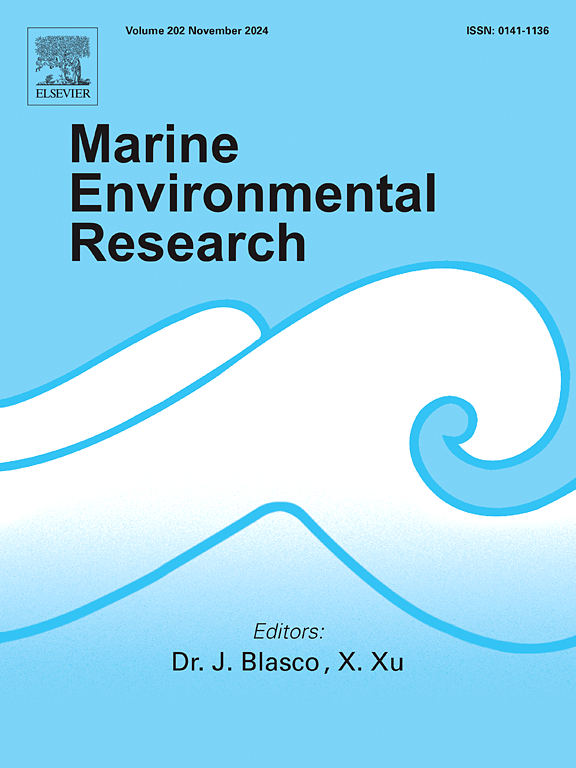Evaluation of microplastics in marine selective and non-selective suspension-feeding benthic invertebrates
IF 3
3区 环境科学与生态学
Q2 ENVIRONMENTAL SCIENCES
引用次数: 0
Abstract
Microplastic (MP) pollution is ubiquitous in marine ecosystems, presenting significant concerns to organisms and fisheries. Suspension-feeding invertebrates are particularly susceptible to encountering and consuming these particles due to their feeding strategy. This meta-analysis assessed MP contamination in selective suspension-feeding (SSF) and non-selective suspension-feeding (NSSF) benthic marine invertebrate species globally. Data reported from 144 peer-reviewed articles, covering as wide of a geographic scope as possible, were extracted and analyzed. In total, 518 independent batches of organisms (i.e. rows in the spreadsheet) were compiled, representing seven Phyla, 12 Classes, 53 Families, and 131 species. In both SSFs and NSSFs, microfibers and fragments were the most common MP shapes found, with polyethylene, polyethylene terephthalate, and polypropylene being the predominant polymer types. While the mean detection frequencies of MPs within individuals of each independent sample batch were similar between SSFs (63 % ± 18 95 %CI) and NSSFs (73 % ± 5 95 %CI), NSSFs had significantly greater MP concentrations than SSFs (i.e. 9.13 MPs ind-1 ±8.87 95 %CI; 138.52.74 MP g ww−1 ±114.6 95 %CI vs. 6.33 MPs ind-1 ±1.53 95 %CI; 3.45 MP g ww−1 ±1.19 95 %CI, respectively). Significant differences in the relative abundance of MPs were also found based on taxonomy. Collectively, these results highlight important differences in MP concentrations in suspension-feeding benthic invertebrates globally and may help inform future efforts in determining appropriate sentinel species for future MP surveys.
海洋选择性和非选择性悬浮食性底栖无脊椎动物中微塑料的评价
微塑料污染在海洋生态系统中无处不在,给生物和渔业带来了重大问题。悬浮进食的无脊椎动物由于其进食策略,特别容易遇到和消耗这些颗粒。本荟萃分析评估了全球范围内选择性悬浮摄食(SSF)和非选择性悬浮摄食(NSSF)底栖海洋无脊椎动物物种的MP污染情况。从144篇同行评议的文章中提取并分析了数据,这些文章涵盖了尽可能广泛的地理范围。总共编译了518个独立批次的生物(即电子表格中的行),代表7门,12纲,53科和131种。在ssf和nssf中,微纤维和碎片是最常见的MP形状,聚乙烯、聚对苯二甲酸乙二醇酯和聚丙烯是主要的聚合物类型。虽然每个独立样品批次个体内MPs的平均检测频率在SSFs(63%±18 95% CI)和nsfs(73%±5 95% CI)之间相似,但nsfs的MP浓度显著高于SSFs(即9.13 MPs和-1±8.87 95% CI;138.52.74 MP g w -1±114.6 95% CI vs. 6.33 MP d-1±1.53 95% CI;3.45 MP g ww−1±1.19 95% CI)。在MPs的相对丰度上也发现了基于分类学的显著差异。总的来说,这些结果突出了全球悬浮摄食底栖无脊椎动物中MP浓度的重要差异,并可能有助于为未来的MP调查确定适当的前哨物种。
本文章由计算机程序翻译,如有差异,请以英文原文为准。
求助全文
约1分钟内获得全文
求助全文
来源期刊

Marine environmental research
环境科学-毒理学
CiteScore
5.90
自引率
3.00%
发文量
217
审稿时长
46 days
期刊介绍:
Marine Environmental Research publishes original research papers on chemical, physical, and biological interactions in the oceans and coastal waters. The journal serves as a forum for new information on biology, chemistry, and toxicology and syntheses that advance understanding of marine environmental processes.
Submission of multidisciplinary studies is encouraged. Studies that utilize experimental approaches to clarify the roles of anthropogenic and natural causes of changes in marine ecosystems are especially welcome, as are those studies that represent new developments of a theoretical or conceptual aspect of marine science. All papers published in this journal are reviewed by qualified peers prior to acceptance and publication. Examples of topics considered to be appropriate for the journal include, but are not limited to, the following:
– The extent, persistence, and consequences of change and the recovery from such change in natural marine systems
– The biochemical, physiological, and ecological consequences of contaminants to marine organisms and ecosystems
– The biogeochemistry of naturally occurring and anthropogenic substances
– Models that describe and predict the above processes
– Monitoring studies, to the extent that their results provide new information on functional processes
– Methodological papers describing improved quantitative techniques for the marine sciences.
 求助内容:
求助内容: 应助结果提醒方式:
应助结果提醒方式:


